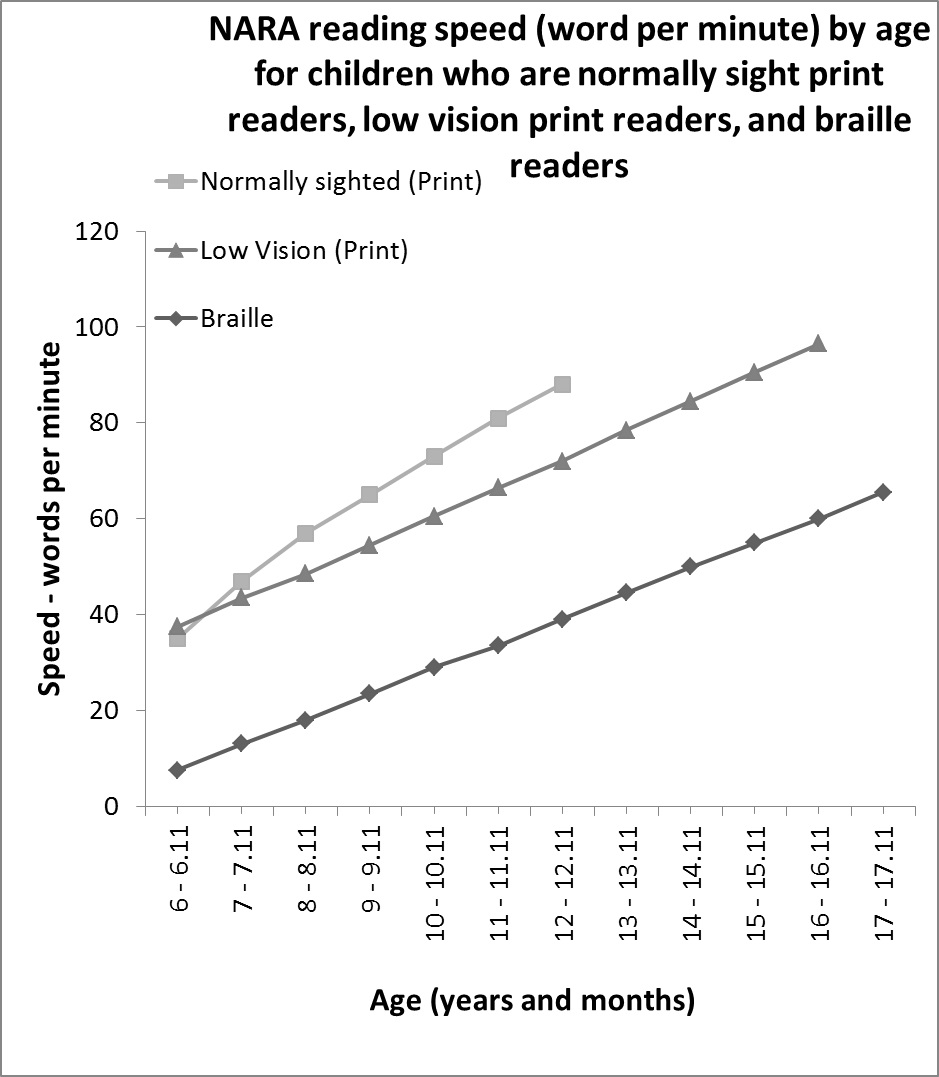Support - Research - Reading rates
Measuring reading speed
This is an excerpt from 'A review of the literature into effective practice in teaching literacy through braille', McCall, McLinden and Douglas, University of Birmingham (2011)
Speed of reading has become a particular focus for attention in the debate about the choice of reading media. Lusk and Corn (2006) acknowledge that while reading speed should not be the only criterion, it is important for children to develop a 'functional and competitive reading speed in either print or braille' (p655). Given the increased inclusion of children with visual impairment in mainstream schools it is perhaps inevitable that increasing comparisons will be made with the reading performance with children who are fully sighted. Wolffe (2000) asserts that for any job in which literacy is used, a minimum silent reading rate of 150 words per minute (wpm) should be expected.
Koenig suggested that by plotting a child's reading rates over the first 3-4 years of schooling, it was possible to predict reading rates at secondary school level.
Expected reading speeds
The following graph shows the average oral reading speeds for different types of readers using the NARA (braille readers, low vision print readers and normally sighted print readers). Data is taken from the NARA standardised reading score for sighted children (Neale, 1997), Greaney et al (1998) and Douglas et al (2002).
The graph gives some indication of the oral reading speed which might be expected from braille readers at given school ages. Children with low vision might be expected to read more quickly and if severity of sight loss appears to be responsible for reading speeds slower than potential braille reading speeds then this will provide some evidence that braille may be a more suitable reading media.
It should be taken into account that the reading speeds derived for the low vision readers by Douglas et al did not include optimised print presentation (with enlarged print or LVAs).
The Paths to Literacy website includes ideas for helping struggling braille readers to increase their fluency.

Silent reading rates
Up to date information on silent braille reading rates is difficult to find, but here are some historic findings:
Lowenfeld, Able and Hatlen (1969) had found that 149 wpm was a typical silent reading rate for braille readers in lower secondary classes of mainstream schools. After reviewing a range of studies on reading speeds, Koenig (1996) suggested that if a child was not expected to achieve a silent reading speed of 100-125 wpm through print, a teacher may need to consider braille as an alternative medium.
Wolffe (2000) asserted that for any job in which literacy is used, a minimum silent reading rate of 150 words per minute (wpm) should be expected.
Inevitably, as with sighted readers, the silent and oral rates of braille readers will show great variation, and braille reading speed will be determined by a wide range of factors. Each case needs to be considered individually and we should be wary of making simplistic comparisons and jumping to conclusions. Perhaps the key reason for measuring reading rates is to be able to track the rate of progress within-child over time. Measuring within-child reading rates over time will indicate if the child's reading speed is progressing steadily or plateauing.
Comparing reading rates with fully sighted children
It is not always helpful to make snap comparisons between the child's performance and the mean reading rates of sighted children. However, there are figures relating to fully sighted children's average reading speeds. These are American norms but they may give you an idea of the performance range at different points in a pupil's progress through school.